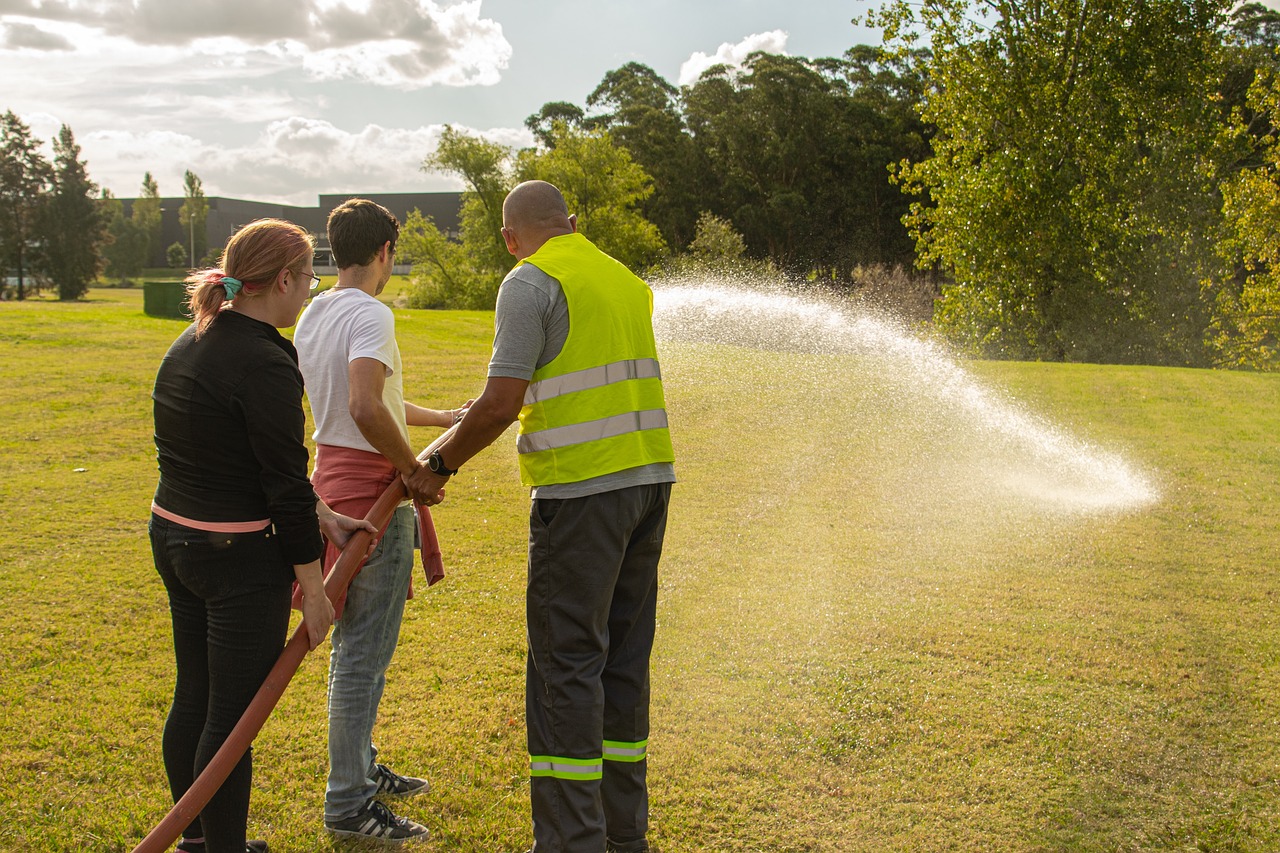How Human Behavior Can Define Safety Standards?
The intricate relationship between human behavior and safety standards is a fascinating subject that often goes unnoticed. When we think about safety, we typically envision rules, regulations, and protocols designed to keep us out of harm's way. However, the reality is that human behavior plays a pivotal role in how these safety measures are perceived and implemented. In fact, understanding the psychology behind human actions can significantly enhance the effectiveness of safety protocols. This article will delve into how psychological factors influence safety standards and why recognizing human behavior is crucial for developing effective safety measures.
To grasp the essence of safety standards, we must first consider the myriad of psychological and social factors that govern decision-making in potentially hazardous situations. For instance, think about a construction site where workers are constantly reminded to wear helmets. Despite these reminders, some individuals might choose to forgo this safety gear. Why? This behavior often stems from a complex interplay of perception, cognitive biases, and social influences. By exploring these elements, we can uncover the reasons behind unsafe behaviors and how to address them effectively.
One key aspect to consider is the role of perception in safety. Individuals perceive risks and hazards through their unique lenses, shaped by past experiences, cultural backgrounds, and social contexts. This perception can significantly affect how they respond to safety measures. For example, a worker who has never experienced an accident may underestimate the importance of safety protocols, believing that they are invincible. This sense of invulnerability can lead to dangerous complacency, ultimately jeopardizing not only their safety but also the safety of those around them.
Furthermore, cognitive biases play a significant role in shaping our safety behaviors. These biases can cloud judgment and lead individuals to make decisions that contradict established safety protocols. For instance, the confirmation bias may cause someone to disregard safety warnings, focusing only on information that aligns with their beliefs. Similarly, the optimism bias can lead individuals to underestimate risks, creating a false sense of security. Understanding these biases is essential for developing training programs that effectively address and mitigate unsafe behaviors.
In addition to psychological factors, social influences significantly impact safety behavior. The norms and expectations within a workplace can either foster a culture of safety or encourage risky behaviors. Peer pressure can be a double-edged sword; while it can motivate individuals to adhere to safety practices, it can also lead them to engage in unsafe behaviors to fit in. Therefore, cultivating a positive safety culture within organizations is paramount. This involves not only enforcing rules but also encouraging open communication about safety concerns and recognizing safe behaviors among employees.
In conclusion, the way human behavior interacts with safety standards is complex and multifaceted. By understanding the psychological and social factors that influence decision-making, we can create more effective safety protocols that resonate with individuals. As we continue to explore this relationship, it becomes clear that enhancing safety isn't just about implementing rules—it's about understanding and shaping human behavior.
- What is the role of human behavior in safety standards?
Human behavior significantly impacts how safety measures are perceived and followed. Understanding the psychology behind decisions can lead to more effective safety protocols. - How do cognitive biases affect safety?
Cognitive biases, such as confirmation bias and optimism bias, can lead individuals to underestimate risks and overlook safety warnings, resulting in unsafe behaviors. - Why is social influence important in safety?
Social norms and peer pressure can shape safety behaviors, making it crucial to foster a positive safety culture within organizations. - What can organizations do to improve safety?
Organizations can enhance safety by implementing effective training programs, encouraging open communication, and recognizing safe behaviors among employees.

Understanding Human Behavior in Safety
This article explores the intricate relationship between human behavior and safety standards, examining how psychological factors influence safety protocols and the importance of understanding human actions in creating effective safety measures.
Understanding human behavior is crucial when it comes to defining safety standards. Why, you ask? Well, our actions and decisions are often influenced by a myriad of psychological and social factors that can either enhance or undermine safety protocols. Think about it: when faced with a potentially hazardous situation, how we react can depend on our perception of risk, our past experiences, and even the social environment we find ourselves in. It's like navigating through a maze where each turn could either lead to safety or danger.
One of the first things to consider is how individuals process information. Our brains are wired to make quick decisions, especially in emergencies. However, this rapid decision-making can sometimes lead to oversights. For instance, if someone has been trained to follow certain safety protocols but feels rushed or pressured, they might skip crucial steps without even realizing it. This is where understanding the nuances of human behavior becomes essential. By identifying the factors that influence our decisions, we can create more effective safety measures that account for these tendencies.
Moreover, social dynamics play a significant role in shaping safety behaviors. The influence of peers and organizational culture can either promote a strong safety ethic or foster a lax attitude towards safety measures. When employees see their colleagues disregarding safety protocols, they might feel compelled to follow suit, thinking, "If they can do it, so can I." This ripple effect highlights the need for organizations to foster a culture of safety where positive behaviors are encouraged and rewarded.
To illustrate this point further, let's consider a few key factors that influence human behavior in safety contexts:
- Risk Perception: How individuals assess the likelihood and severity of risks can greatly impact their safety decisions.
- Emotional Responses: Fear, anxiety, or overconfidence can cloud judgment and lead to unsafe practices.
- Social Influence: The behavior of peers can either encourage adherence to safety protocols or lead to complacency.
By understanding these elements, organizations can tailor their safety protocols to align more closely with how humans naturally behave. This might involve redesigning training programs, implementing better communication strategies, or even utilizing technology to reinforce safe behaviors. Ultimately, the goal is to create an environment where safety becomes second nature, rather than an afterthought.
- What are the main psychological factors that influence safety behavior? Psychological factors include risk perception, emotional responses, and cognitive biases that affect decision-making.
- How can organizations improve safety standards? Organizations can improve safety by fostering a culture of safety, providing ongoing training, and utilizing technology to monitor and encourage safe behaviors.
- Why is understanding human behavior important for safety? Understanding human behavior is essential because it helps organizations tailor safety measures that align with how people naturally act, reducing the likelihood of accidents.

The Role of Perception in Safety
When we think about safety, one might assume that it’s all about rules, regulations, and protocols. However, the reality is much more complex. Perception plays a crucial role in how individuals respond to safety measures and hazards. Our perceptions can be influenced by a myriad of factors, including past experiences, cultural background, and even the environment we find ourselves in. For instance, if someone has never experienced an accident, they may perceive a risky situation as safe, leading to a false sense of security. This perception can ultimately endanger not just themselves but also those around them.
Moreover, the way we perceive risks can significantly affect our decision-making processes. When confronted with a hazardous situation, individuals often rely on their gut feelings rather than objective data. This reliance on personal perception can lead to varying responses to safety protocols. For example, if a worker believes that wearing personal protective equipment (PPE) is unnecessary, they may choose to forgo it, putting themselves at risk. On the flip side, someone who has had prior training and understands the importance of PPE will likely adhere to safety guidelines more rigorously.
Additionally, the effectiveness of safety measures can be compromised by how people perceive the risks involved. If safety protocols are viewed as overly stringent or unnecessary, compliance may dwindle. This highlights the importance of effective communication in safety training. Organizations must ensure that employees not only understand the why behind safety measures but also feel that their concerns and perceptions are valued. A culture of safety should encourage open dialogue, allowing individuals to express their views on safety practices.
Interestingly, the perception of risk is not always aligned with reality. Research indicates that individuals often underestimate certain dangers while overestimating others. For instance, people might perceive driving in bad weather as risky but underestimate the hazards associated with everyday tasks, such as using a ladder. This discrepancy can lead to unsafe behaviors and a lack of adherence to safety protocols. To combat this, organizations can utilize risk perception training, helping employees understand the actual risks associated with various tasks and how to mitigate them effectively.
In conclusion, perception is a double-edged sword in the realm of safety. While it can empower individuals to make informed decisions, it can also lead to complacency and risky behaviors if not managed properly. Organizations must strive to create an environment where safety perceptions are aligned with actual risks, fostering a culture that prioritizes safety through effective communication, training, and continuous feedback.

Cognitive Biases and Safety
When we think about safety in various environments, it’s easy to assume that people will always make the right choices. However, the reality is that cognitive biases can significantly distort our judgment, leading to unsafe behaviors and decisions. These biases are mental shortcuts our brains take to simplify information processing, but they can often lead us astray, especially in high-stakes situations. For instance, when faced with a safety warning, an individual might unconsciously filter the information through their personal beliefs, causing them to dismiss crucial safety protocols. This phenomenon can have dire consequences in workplaces, where the stakes are high, and the margin for error is slim.
One of the most prevalent cognitive biases affecting safety is confirmation bias. This occurs when individuals seek out information that confirms their pre-existing beliefs while ignoring evidence that contradicts them. Imagine a worker who believes that wearing a helmet is unnecessary because they have never experienced an accident. They may overlook safety training sessions emphasizing the importance of head protection, focusing instead on anecdotes of colleagues who have worked without helmets for years. This selective attention not only endangers their safety but can also influence others around them, creating a culture of negligence.
Another common bias is optimism bias, where individuals underestimate the likelihood of negative outcomes. This can lead to a false sense of security, causing workers to engage in risky behaviors, such as skipping safety checks or ignoring proper equipment usage. For example, a construction worker might think, "I’ve done this a hundred times without any issues; I don’t need to double-check my harness today." This kind of thinking can be a ticking time bomb, as it increases the chances of accidents happening, often with severe consequences.
Understanding these cognitive biases is crucial for improving safety standards. Organizations can implement training programs that specifically address these biases, helping employees recognize and mitigate their effects. By fostering an awareness of how these biases operate, companies can encourage a more proactive approach to safety. It’s about creating an environment where questioning one's assumptions becomes the norm, and safety is prioritized over complacency.
Ultimately, the interplay between cognitive biases and safety is a complex one, but by recognizing these biases and actively working to counteract them, we can significantly enhance safety protocols. It’s not just about enforcing rules; it’s about changing mindsets. As we delve deeper into the relationship between human behavior and safety, it becomes clear that addressing cognitive biases is a fundamental step toward fostering a safer workplace.
- What are cognitive biases? Cognitive biases are systematic patterns of deviation from norm or rationality in judgment, leading to illogical inferences or decisions.
- How do cognitive biases affect safety? They can lead individuals to underestimate risks or dismiss safety protocols, ultimately increasing the likelihood of accidents.
- What can organizations do to mitigate cognitive biases? Organizations can implement training programs that raise awareness of these biases and encourage safe practices.

Confirmation Bias
Confirmation bias is a fascinating psychological phenomenon that can significantly impact safety behaviors. Imagine you're driving and you see a sign warning of a slippery road ahead. If you have a strong belief that you are a skilled driver and that such warnings are often exaggerated, your mind may filter out this crucial information. Instead, you might focus on anecdotes from friends who have driven under similar conditions without incident. This selective attention can lead to dangerous decisions, as you might ignore the very real risks present in that moment.
This bias not only affects individual decision-making but can also permeate organizational culture. For example, if a workplace has a history of low accident rates, employees might develop a false sense of security. They may downplay safety protocols, believing that their environment is inherently safe. This mindset can create a dangerous cycle: as people overlook safety measures, the likelihood of accidents increases, reinforcing their original belief that their environment is safe. Consequently, they may continue to disregard safety warnings, leading to potentially catastrophic outcomes.
To combat confirmation bias, organizations must foster an environment that encourages open dialogue about safety concerns. Here are a few strategies:
- Training Programs: Implement regular training that highlights the importance of adhering to safety protocols, regardless of past experiences.
- Encouraging Reporting: Create a culture where employees feel comfortable reporting near misses or unsafe conditions without fear of retribution.
- Data-Driven Decisions: Utilize data and statistics to inform safety protocols rather than relying solely on anecdotal evidence.
By understanding and addressing confirmation bias, organizations can enhance their safety standards and ensure that all employees recognize the importance of adhering to safety measures. It's not just about following rules; it's about cultivating a mindset that prioritizes safety above all else, even when the evidence seems to suggest otherwise.
Q1: What is confirmation bias?
A1: Confirmation bias is a psychological tendency to search for, interpret, and remember information in a way that confirms one’s pre-existing beliefs or values, often leading to the dismissal of contrary evidence.
Q2: How does confirmation bias affect safety in the workplace?
A2: It can lead employees to overlook safety warnings and protocols, believing that their past experiences or skills are sufficient to keep them safe, which can increase the risk of accidents.
Q3: What can organizations do to mitigate confirmation bias?
A3: Organizations can implement training programs, encourage open reporting of safety issues, and rely on data-driven decision-making to counteract the effects of confirmation bias.

Optimism Bias
Optimism bias is a fascinating psychological phenomenon where individuals tend to believe that they are less likely to experience negative events compared to others. This cognitive distortion can be particularly dangerous in the context of safety standards, as it often leads people to underestimate risks associated with hazardous situations. Imagine you're driving a car; you might think, "I’m a great driver, accidents happen to other people." This mindset can foster a sense of complacency, causing individuals to ignore safety protocols that are put in place to protect them.
In the workplace, this bias can manifest in various ways. Employees might think, "I don’t need to wear my safety gear; I’ve been fine without it so far." This thought process not only jeopardizes their safety but also sets a poor example for their colleagues. When optimism bias is prevalent, it can create an environment where safety measures are seen as unnecessary inconveniences rather than essential practices designed to prevent accidents.
To illustrate the impact of optimism bias on safety, consider the following table that outlines common scenarios and the potential consequences of ignoring safety protocols:
| Scenario | Optimistic Thought | Potential Consequence |
|---|---|---|
| Working at heights | "I’m careful; I won’t fall." | Severe injuries or fatalities from falls |
| Handling hazardous materials | "I’ve done this many times; I know what I’m doing." | Exposure to toxic substances, health issues |
| Ignoring safety signs | "Those warnings are for other people." | Increased risk of accidents and injuries |
Addressing optimism bias is crucial for enhancing safety standards. Organizations can implement strategies such as regular safety training sessions, where employees are encouraged to share their experiences and discuss the real consequences of ignoring safety protocols. By fostering an open dialogue, companies can help individuals recognize the fallacy in their optimistic beliefs and promote a culture of safety awareness.
Additionally, incorporating real-life case studies during training can serve as a powerful reminder of the importance of vigilance. When employees see the tangible outcomes of neglecting safety measures, it can effectively counteract their optimistic views. Ultimately, understanding and mitigating optimism bias is essential for creating a safer work environment and ensuring that safety standards are not only recognized but also actively followed.
- What is optimism bias?
Optimism bias is the belief that one is less likely to experience negative events compared to others, often leading to a disregard for safety measures.
- How does optimism bias affect workplace safety?
It can lead employees to underestimate risks and ignore safety protocols, increasing the likelihood of accidents and injuries.
- What can organizations do to combat optimism bias?
Implementing regular safety training and discussing real-life case studies can help employees recognize the risks and the importance of following safety protocols.

Social Influences on Safety Behavior
When it comes to safety, human behavior is not just an individual affair—it's deeply intertwined with social influences. Think about it: how often do we find ourselves doing something simply because everyone around us is doing it? This phenomenon is particularly pronounced in workplace settings, where social norms can either bolster or undermine safety practices. For instance, if a group of employees consistently ignores safety protocols, new members may feel pressured to follow suit, believing that this behavior is the norm. In essence, our social circles can dictate our actions, sometimes leading us down a hazardous path.
The impact of peer pressure on safety behavior cannot be overstated. In many cases, individuals prioritize acceptance and belonging over adherence to safety standards. Imagine a construction site where workers skip wearing helmets because they want to fit in with their colleagues. This seemingly innocuous choice can lead to dire consequences. It's crucial for organizations to recognize this dynamic and actively work to cultivate a culture of safety. By fostering an environment where safety is valued and celebrated, companies can shift the focus from social acceptance to safe practices.
To illustrate this point further, consider the following table that summarizes the effects of social influences on safety behavior in the workplace:
| Social Influence | Effect on Safety Behavior |
|---|---|
| Peer Pressure | Encourages risky behavior if the group disregards safety protocols |
| Leadership Behavior | Sets the tone for safety culture; leaders who prioritize safety inspire others to do the same |
| Group Norms | Can either promote safe practices or normalize unsafe behaviors |
Furthermore, the role of leadership in shaping safety behavior is paramount. Leaders who actively demonstrate safe practices not only set a standard but also create a ripple effect throughout the organization. When employees see their leaders donning safety gear, following protocols, and prioritizing safety discussions, they are more likely to emulate those behaviors. In contrast, if leaders neglect safety measures, it sends a message that safety is not a priority, leading to a culture where unsafe behaviors are tolerated.
In conclusion, understanding the social influences on safety behavior is essential for developing effective safety protocols. Organizations must be proactive in addressing these influences by promoting a strong safety culture, encouraging open communication about safety concerns, and leading by example. By doing so, they can transform safety from a mere set of rules into a shared value that everyone embraces. After all, when safety becomes a collective responsibility, everyone wins.
- What are social influences on safety behavior? Social influences refer to the impact that peer pressure, group norms, and leadership have on individuals' adherence to safety protocols.
- How can organizations foster a culture of safety? Organizations can promote safety by encouraging open communication, recognizing safe behaviors, and ensuring that leaders model safety practices.
- Why is leadership important in safety behavior? Leadership sets the tone for the organization's approach to safety; leaders who prioritize safety inspire their teams to follow suit.

Training and Education for Safety
When it comes to safety in any environment, whether it’s in the workplace, at home, or in public spaces, training and education play a pivotal role. It’s not just about having protocols in place; it’s about ensuring that everyone understands the importance of these protocols and how to follow them. Imagine a world where every individual is not only aware of the risks but is also equipped with the knowledge and skills to mitigate those risks. This is the essence of effective safety training.
Training programs tailored to specific environments can significantly alter perceptions and behaviors regarding safety. For instance, in manufacturing settings, workers might be trained on how to properly use machinery, recognize hazards, and respond to emergencies. This proactive approach not only minimizes risks but also cultivates a sense of responsibility among employees. When people feel empowered through education, they are more likely to take safety seriously.
Moreover, it’s essential to recognize that safety training is not a one-time event. Just like how we continuously learn and adapt in our personal lives, safety protocols must evolve to meet changing circumstances and emerging risks. This is where continuous learning comes into play. Organizations should implement ongoing training sessions that incorporate the latest safety standards, technologies, and best practices. Regular feedback mechanisms can also help in identifying areas for improvement, ensuring that the safety culture remains dynamic and responsive.
To illustrate the impact of training on safety, consider the following table that outlines key components of effective safety training programs:
| Component | Description |
|---|---|
| Hands-On Training | Practical sessions that allow individuals to practice safety protocols in real-life scenarios. |
| Regular Assessments | Periodic evaluations to gauge the effectiveness of training and identify knowledge gaps. |
| Feedback Loops | Mechanisms for employees to provide input on safety practices and training effectiveness. |
| Updates on Regulations | Keeping employees informed about changes in safety laws and standards. |
In addition to structured training, fostering a culture of safety within an organization is crucial. This involves encouraging open communication, where employees feel comfortable discussing safety concerns without fear of repercussion. When safety becomes a shared responsibility, it not only enhances compliance but also builds trust among team members. After all, a workplace where safety is prioritized is a workplace where productivity thrives.
Now, let’s not forget the role of technology in enhancing training and education for safety. With advancements in virtual reality (VR) and augmented reality (AR), organizations can simulate hazardous situations, allowing employees to practice their responses in a controlled environment. This immersive experience can drastically improve retention and understanding of safety protocols, making training not only more engaging but also more effective.
In conclusion, the relationship between training, education, and safety is undeniable. By investing in comprehensive training programs and fostering a culture that prioritizes safety, organizations can significantly reduce the likelihood of accidents and create a safer environment for everyone involved. Remember, safety is not just a set of rules; it’s a mindset that can be cultivated through education and awareness.
- What is the importance of safety training?
Safety training is crucial because it equips individuals with the knowledge and skills to recognize and mitigate risks, thereby reducing the likelihood of accidents. - How often should safety training be conducted?
Safety training should be conducted regularly, with updates provided as new risks or regulations emerge. Continuous learning ensures that employees remain informed and compliant. - What role does technology play in safety training?
Technology, such as VR and AR, enhances safety training by providing immersive experiences that allow employees to practice their responses to hazardous situations in a safe environment.

Behavioral Safety Training
Behavioral safety training is an essential component in fostering a culture of safety within any organization. It goes beyond the traditional approaches of merely instructing employees on safety protocols; instead, it focuses on understanding and modifying behaviors that contribute to unsafe practices. By addressing the psychological aspects of decision-making, organizations can significantly reduce the incidence of accidents and injuries. But how exactly does this training work, and why is it so effective?
The core of behavioral safety training lies in its ability to make individuals aware of their actions and the consequences that follow. It encourages employees to take ownership of their safety and that of their colleagues. This is achieved through various methods, including workshops, role-playing scenarios, and interactive discussions that engage participants and make them reflect on their behaviors. For instance, a workshop might involve a scenario where employees must identify potential hazards in a simulated work environment, prompting them to think critically about their surroundings and the safety measures in place.
One of the key benefits of behavioral safety training is that it helps to identify and address specific unsafe behaviors that may be prevalent within a workplace. For example, if a company notices a pattern of employees not wearing personal protective equipment (PPE), the training can focus on the reasons behind this behavior. Is it due to a lack of understanding of the risks? Or perhaps a belief that "it won't happen to me"? By addressing these underlying issues, organizations can tailor their training programs to be more effective.
Moreover, behavioral safety training fosters an environment of open communication. When employees feel comfortable discussing safety concerns without fear of retribution, they are more likely to report unsafe conditions and behaviors. This creates a feedback loop where employees can learn from each other, share best practices, and collectively improve safety standards. In fact, organizations that prioritize this type of training often see a marked improvement in their safety records, as employees become more vigilant and proactive about safety.
To illustrate the effectiveness of behavioral safety training, consider the following table that outlines key components and their impact:
| Training Component | Impact on Safety |
|---|---|
| Workshops and Role-Playing | Enhances awareness and critical thinking about safety hazards. |
| Open Communication | Encourages reporting of unsafe behaviors and conditions. |
| Tailored Training Programs | Addresses specific unsafe behaviors within the organization. |
| Continuous Feedback | Promotes ongoing improvement in safety practices. |
Ultimately, behavioral safety training is not just a one-time event; it is an ongoing process that requires commitment from both management and employees. By continually reinforcing safe behaviors and adapting training to meet the evolving needs of the workforce, organizations can create a sustainable safety culture that prioritizes the well-being of all employees. So, are you ready to embrace behavioral safety training and transform your workplace into a safer environment?
- What is behavioral safety training? Behavioral safety training focuses on modifying unsafe behaviors through awareness and education, rather than just teaching safety protocols.
- How can organizations implement this training? Organizations can implement this training through workshops, role-playing scenarios, and open discussions that engage employees in safety practices.
- What are the benefits of behavioral safety training? Benefits include increased awareness of safety hazards, improved communication, and a reduction in workplace accidents.
- Is behavioral safety training a one-time event? No, it is an ongoing process that requires continuous reinforcement and adaptation to be effective.

Continuous Learning and Improvement
This article explores the intricate relationship between human behavior and safety standards, examining how psychological factors influence safety protocols and the importance of understanding human actions in creating effective safety measures.
An overview of how human behavior impacts safety standards, highlighting the psychological and social factors that influence decision-making in potentially hazardous situations.
This section discusses how individuals perceive risks and hazards, affecting their response to safety measures and the overall effectiveness of safety protocols.
Explores various cognitive biases that can lead to unsafe behaviors, emphasizing the need for awareness and training to mitigate these biases in safety practices.
Details how confirmation bias can cause individuals to overlook safety warnings, focusing instead on information that supports their existing beliefs about safety.
Examines optimism bias, where individuals underestimate risks, leading to complacency in following safety protocols and increasing the likelihood of accidents.
Discusses how social norms and peer pressure can shape safety behaviors, highlighting the importance of fostering a culture of safety within organizations.
This section emphasizes the significance of training programs in shaping safe behaviors, focusing on how education can effectively alter perceptions and practices regarding safety.
Analyzes the effectiveness of behavioral safety training programs in promoting safer work environments and reducing accidents through behavior modification.
In the ever-evolving landscape of safety standards, play a pivotal role in maintaining a culture of safety. Organizations must recognize that safety is not a one-time training event but a dynamic process that requires ongoing attention and adaptation. Just like a river that carves its path through the landscape, the safety protocols must adapt to the changing contours of human behavior and environmental factors.
One of the most effective ways to ensure continuous improvement is through feedback loops. By actively seeking feedback from employees about safety practices, organizations can identify areas that require enhancement. For instance, regular safety audits and open discussions can surface insights that might otherwise go unnoticed. This feedback can be compiled into a
| Feedback Source | Identified Issues | Action Taken | Follow-Up Date |
|---|---|---|---|
| Employee Surveys | Inadequate PPE | Updated equipment policy | 2023-06-15 |
| Safety Audits | Emergency exits blocked | Cleared pathways | 2023-07-01 |
Moreover, organizations should embrace a culture of learning from mistakes. Instead of assigning blame when accidents occur, a more constructive approach is to analyze incidents to understand their root causes. This approach not only fosters a sense of trust among employees but also encourages them to report near misses and unsafe conditions, which can be invaluable for preventing future incidents.
In addition to internal feedback, organizations can benefit from staying updated with industry best practices and innovations in safety technology. Attending workshops, webinars, and conferences can provide fresh perspectives and tools that can be integrated into existing safety protocols. After all, the world of safety is constantly changing, and what was considered safe yesterday may not hold true today.
Ultimately, the goal of continuous learning and improvement in safety is to create an environment where every individual feels responsible for not only their safety but also the safety of their colleagues. It’s about building a community that values safety as much as productivity. By fostering this culture, organizations can significantly reduce accidents and enhance overall workplace morale.
- Why is continuous learning important in safety? Continuous learning helps organizations adapt to new challenges and improve safety protocols based on real-world feedback.
- How can organizations encourage feedback? Organizations can encourage feedback through regular surveys, open discussions, and creating a non-punitive environment for reporting issues.
- What role does technology play in improving safety? Technology can provide real-time data and analytics, helping organizations identify potential hazards and improve safety measures.

Technology's Impact on Safety Behavior
In today's fast-paced world, technology plays a pivotal role in shaping our safety behaviors. Imagine a construction site buzzing with activity, where workers are equipped not just with hard hats and safety goggles, but also with cutting-edge gadgets designed to enhance their safety. This is the new frontier of safety, where technology and human behavior intersect to create a safer working environment. From mobile applications to wearable technology, the integration of tech into safety protocols has revolutionized how we perceive and respond to hazards.
One of the most significant advancements in this realm is the advent of wearable safety technology. These devices, such as smart helmets and vests embedded with sensors, monitor environmental conditions and the wearer’s vital signs in real-time. For instance, a smart helmet can detect high levels of carbon monoxide and alert the wearer immediately, allowing them to take action before it's too late. This immediate feedback not only enhances individual safety but also fosters a culture of vigilance among peers. The connection between technology and human behavior becomes evident here; when workers know they are being monitored for their safety, they are more likely to adhere to safety protocols.
Moreover, the implementation of apps designed for safety reporting and communication has transformed how teams interact regarding potential hazards. These applications allow workers to report unsafe conditions instantly, creating a more responsive and proactive safety culture. Consider a scenario where a worker notices a spill in a high-traffic area. Instead of waiting for a supervisor to address the issue, they can quickly report it through an app, prompting immediate action. This shift in behavior demonstrates how technology can empower individuals to take ownership of their safety and that of their colleagues.
Another groundbreaking development is the use of artificial intelligence (AI) in predictive safety analysis. By analyzing vast amounts of data related to human behavior, AI can identify patterns that may predict future safety incidents. For example, if data shows that accidents tend to occur during specific shifts or under certain environmental conditions, organizations can implement targeted interventions to mitigate these risks. This proactive approach not only enhances safety but also encourages a culture of continuous improvement, as employees feel supported by data-driven decision-making.
To illustrate the impact of technology on safety behavior, consider the following table that highlights various technological tools and their effects on safety practices:
| Technology | Impact on Safety Behavior |
|---|---|
| Wearable Technology | Monitors vital signs and environmental hazards, providing real-time alerts. |
| Safety Reporting Apps | Facilitates immediate reporting of hazards, promoting proactive safety measures. |
| AI Predictive Analysis | Identifies risk patterns and informs preventive strategies, enhancing overall safety. |
In conclusion, technology's impact on safety behavior is profound and multifaceted. By leveraging wearables, mobile apps, and AI, organizations can significantly enhance their safety standards. However, it's essential to remember that technology is a tool, not a replacement for human vigilance. The most effective safety practices arise when technology complements human behavior, fostering a culture where safety is everyone's responsibility. So, the next time you strap on a safety harness or check your safety app, remember that you are part of a larger movement towards a safer future.
Q1: How does wearable technology improve safety?
A1: Wearable technology enhances safety by monitoring environmental conditions and the wearer's health in real-time, providing alerts for potential hazards.
Q2: Can safety apps really make a difference?
A2: Yes, safety apps facilitate immediate reporting of hazards, fostering a proactive safety culture and enabling quicker responses to unsafe conditions.
Q3: What role does AI play in safety?
A3: AI analyzes data to identify patterns that predict safety incidents, allowing organizations to implement targeted prevention strategies.

Wearable Safety Technology
In an age where technology is seamlessly integrated into our daily lives, stands out as a game-changer in enhancing workplace safety. Imagine a world where your clothing or accessories could alert you to potential hazards before you even notice them. That's the promise of wearable safety devices. These gadgets, which range from smart helmets to safety vests equipped with sensors, are designed to monitor environmental conditions and the wearer's health, providing real-time feedback that can be crucial in preventing accidents.
One of the most significant benefits of wearable safety technology is its ability to monitor vital signs. For instance, devices can track heart rates, body temperature, and even fatigue levels, alerting the wearer or supervisors when something seems off. This is particularly important in high-risk environments like construction sites or manufacturing plants, where a lapse in attention can lead to serious injuries. By providing immediate data, these devices empower individuals to make informed decisions about their safety and well-being.
Moreover, wearable technology can also facilitate communication among team members. Imagine a construction worker wearing a smart helmet that not only protects their head but also allows them to communicate with their team through voice commands or hands-free devices. This can enhance coordination and ensure that everyone is aware of potential dangers in real-time. The integration of GPS technology in wearables can also help in tracking personnel, ensuring that no one is left behind in hazardous areas.
However, it's essential to recognize that while wearable safety technology offers numerous advantages, it also comes with challenges. For instance, the adoption of these technologies can be met with resistance from employees who may feel uncomfortable or skeptical about wearing devices that monitor their behavior. Therefore, it is crucial for organizations to foster a culture of safety that embraces these innovations rather than viewing them as intrusive. Providing training on how these devices work and demonstrating their benefits can help alleviate concerns and encourage widespread use.
In conclusion, wearable safety technology represents a significant advancement in our approach to workplace safety. By combining health monitoring, communication, and hazard awareness into compact devices, we can create safer environments for everyone. As we continue to innovate and adapt, embracing these technologies will be vital in shaping a culture that prioritizes the well-being of all employees.
- What types of wearable safety technology are available? Wearable safety technology includes smart helmets, safety vests, health monitors, and GPS tracking devices.
- How does wearable technology improve workplace safety? It monitors vital signs, enhances communication, and provides real-time feedback about environmental hazards.
- Are employees resistant to using wearable safety devices? Some employees may be skeptical; thus, proper training and communication about the benefits are essential.
- Can wearable technology track location? Yes, many wearable devices come equipped with GPS technology to track personnel in real-time.

AI and Predictive Safety Analysis
Artificial Intelligence (AI) has revolutionized many sectors, and the realm of safety is no exception. By harnessing the power of AI, organizations can delve deep into the intricate patterns of human behavior, identifying potential safety risks before they manifest into real-world incidents. Imagine having a crystal ball that not only predicts accidents but also provides actionable insights to mitigate them—this is the promise of AI in predictive safety analysis.
At its core, predictive safety analysis leverages vast amounts of data to recognize trends and anomalies in human behavior. By analyzing historical data, AI algorithms can identify which behaviors are likely to lead to unsafe conditions. For instance, if data shows that employees tend to skip safety protocols during certain times of the day or under specific conditions, organizations can proactively address these issues. This predictive capability is akin to having a weather forecast for safety: just as you wouldn't venture out in a storm without an umbrella, you can prepare for potential safety hazards before they arise.
Moreover, AI can analyze various factors that contribute to safety incidents, such as environmental conditions, equipment status, and even employee fatigue levels. By integrating these variables into a comprehensive analysis, AI systems can provide a more holistic view of safety risks. For example, a manufacturing plant might use AI to monitor machine performance and worker behavior simultaneously, allowing it to predict when a machine is likely to malfunction and when workers may be distracted or fatigued, thus increasing the risk of accidents.
One of the most exciting aspects of AI in safety analysis is its ability to learn and improve over time. Machine learning algorithms can adapt based on new data, continually refining their predictive capabilities. This means that as more information becomes available—whether from incident reports, near-misses, or even employee feedback—the AI system becomes more accurate in its predictions. It's like having a safety consultant that never sleeps, constantly absorbing information and adjusting its recommendations accordingly.
Additionally, AI can enhance communication and training efforts. For instance, by analyzing behavioral data, organizations can tailor their safety training programs to address specific weaknesses in their workforce. If the AI identifies that a particular group consistently overlooks certain safety protocols, targeted training can be implemented to rectify this behavior. This personalized approach not only improves compliance but also fosters a culture of safety where employees feel empowered to take ownership of their actions.
In summary, AI and predictive safety analysis represent a significant leap forward in how we approach safety in the workplace. By understanding and predicting human behavior, organizations can create safer environments, reduce the likelihood of accidents, and ultimately save lives. As we continue to embrace technology in our safety protocols, the potential for improvement is limitless.
- What is predictive safety analysis?
Predictive safety analysis uses data and AI to identify potential safety risks by analyzing patterns of human behavior and environmental factors.
- How does AI improve workplace safety?
AI enhances workplace safety by predicting potential incidents, allowing organizations to take proactive measures, and personalizing training programs based on identified risks.
- Can AI adapt to new safety data?
Yes, AI systems can learn from new data, continuously improving their predictive accuracy and recommendations over time.
Frequently Asked Questions
- How does human behavior influence safety standards?
Human behavior plays a crucial role in shaping safety standards. Our psychological and social factors, like perception and cognitive biases, significantly impact how we respond to safety protocols. Understanding these behaviors helps in designing more effective safety measures that resonate with individuals' decision-making processes.
- What are cognitive biases, and how do they affect safety?
Cognitive biases are mental shortcuts that can lead to errors in judgment. For instance, confirmation bias may cause individuals to ignore safety warnings that contradict their beliefs, while optimism bias can lead to underestimating risks. Recognizing these biases is essential to develop training programs that promote safer behaviors.
- How can social influences impact safety behaviors?
Social influences, such as peer pressure and organizational culture, significantly affect safety behaviors. When safety norms are established and reinforced within a group, individuals are more likely to adopt safe practices. Cultivating a strong safety culture is essential for encouraging responsible behavior among team members.
- What role does training play in promoting safety?
Training is vital for instilling safe behaviors and altering perceptions about safety protocols. Behavioral safety training programs are designed to modify actions and attitudes towards safety, thereby reducing accidents and fostering a proactive approach to safety in the workplace.
- How does technology enhance safety behavior?
Technology, such as wearable safety devices and safety apps, plays an increasingly important role in promoting safe practices. These tools provide real-time monitoring and feedback, helping individuals stay aware of potential hazards and encouraging adherence to safety protocols.
- Can AI predict safety issues based on human behavior?
Yes! Artificial intelligence can analyze patterns in human behavior to predict potential safety issues. By leveraging data analytics, AI can inform proactive safety measures, enabling organizations to address risks before they lead to accidents.



















